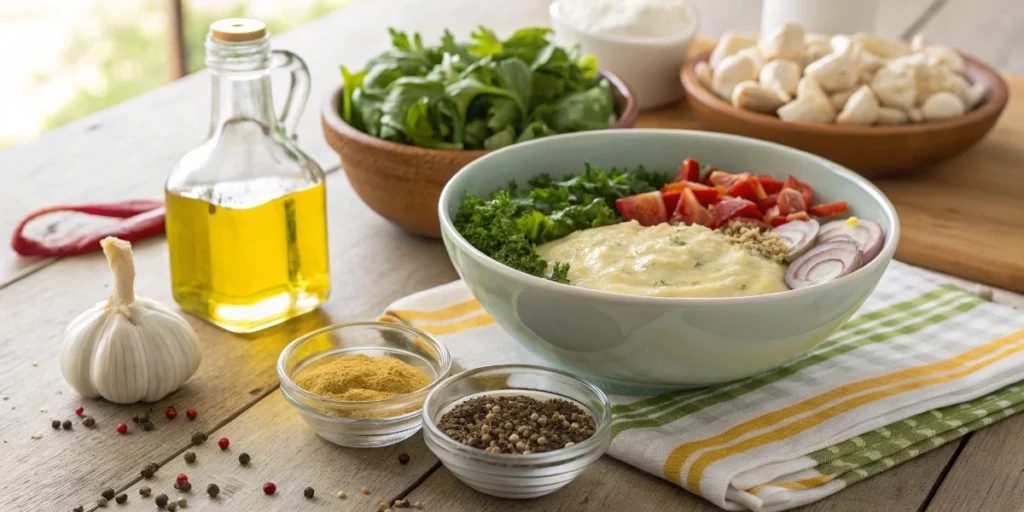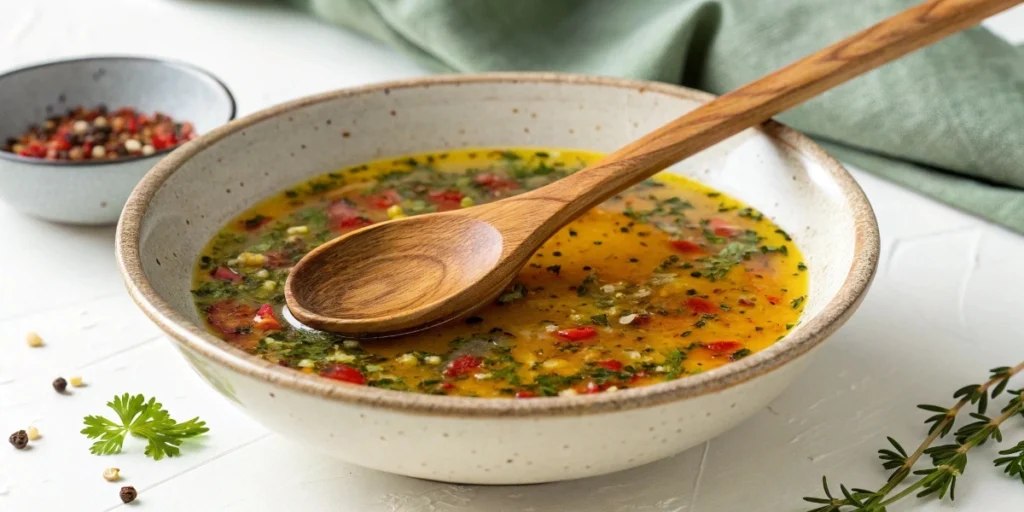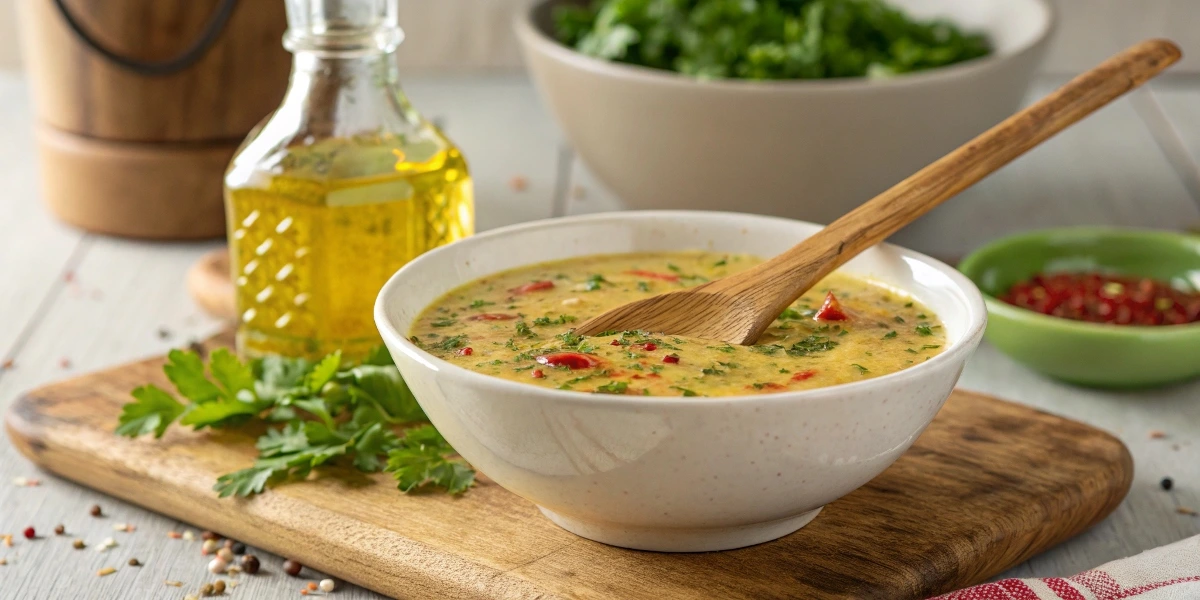Mastering Salad Dressing: Top Recipes
Salad dressing plays a pivotal role in transforming a simple bowl of greens into a delightful culinary experience. Whether you’re a fan of tangy vinaigrettes or creamy dressings, there’s something for everyone when it comes to crafting the perfect salad accompaniment. In this comprehensive guide, we’ll explore everything you need to know about salad dressing—from its history and types to easy recipes and storage tips. Let’s dive in.
Table of Contents
Chapter 1: What Is Salad Dressing?
At its core, salad dressing is a liquid condiment used to enhance the flavor of salads. It can be as simple as a drizzle of olive oil and vinegar or as complex as a blended mixture of herbs, spices, and dairy products. Salad dressings have been around for centuries, with ancient civilizations using oils, vinegars, and other natural ingredients to complement their meals 6.
Why Make Your Own Salad Dressing?
Making your own salad dressing at home offers numerous benefits:
- Freshness : Homemade dressings are fresher than store-bought options.
- Customization : You can tailor the flavors to suit your taste preferences.
- Health Benefits : By controlling ingredients, you can create healthier alternatives that align with dietary goals.
For example, if you’re looking for an oil-free option, try this recipe inspired by [My Everyday Oil-Free Salad Dressing] 5. It uses lemon juice, Dijon mustard, nutritional yeast, and agave syrup to deliver a tangy yet satisfying flavor profile.
Chapter 2: Types of Salad Dressings
There are countless varieties of salad dressings, each offering unique flavors and textures. Here’s a breakdown of the most popular types:
1. Vinaigrettes
Vinaigrettes are perhaps the simplest and most classic form of salad dressing. They typically consist of oil, vinegar, and seasonings. A basic vinaigrette follows a 3:1 ratio of oil to acid (vinegar or citrus juice). For instance, the [Best Simple Vinaigrette Recipe] suggests combining olive oil, red wine vinegar, salt, pepper, and Dijon mustard for a balanced and flavorful result 6.
Tips for Perfect Vinaigrettes:
- Use high-quality oils and vinegars for better taste.
- Experiment with different acids like balsamic vinegar, apple cider vinegar, or lime juice.
- Add fresh herbs such as basil, thyme, or rosemary for extra aroma.
2. Creamy Dressings
Creamy dressings provide a rich and indulgent texture, often incorporating dairy products like yogurt, sour cream, or mayonnaise. However, vegan and healthier alternatives exist too. Consider making a heart-healthy Caesar dressing using avocado oil instead of traditional mayonnaise 7.
Essential Salad Dressing Recipes for Every Taste:
Try this [Oil-Free Vegan Salad Dressing] that combines lemon juice, Dijon mustard, fresh herbs, and nutritional yeast for a creamy yet nutritious option 9.
3. Oil-Free Dressings
If you’re aiming for healthier choices, oil-free dressings are a great alternative. These dressings rely on ingredients like water, silken tofu, unsweetened applesauce, flax seeds, nuts, or even fruit juices to achieve a smooth consistency 7.
Example:
This [Everyday Oil-Free Salad Dressing] uses lemon juice, Dijon mustard, nutritional yeast, and agave syrup to create a zesty and flavorful dressing without any added oils 5.
Chapter 3: How to Make Salad Dressing at Home?

Creating your own salad dressing is easier than you might think. Follow these step-by-step instructions to craft delicious dressings from scratch.
Step 1: Choose Your Base
Decide whether you want an oil-based, dairy-based, or oil-free dressing. Common bases include olive oil, yogurt, silken tofu, or water.
Step 2: Select Acids
Acids add tanginess and balance the richness of oils or creams. Popular choices include:
- Lemon juice
- Lime juice
- Red wine vinegar
- Apple cider vinegar
- Balsamic vinegar
Step 3: Add Emulsifiers
Emulsifiers help blend oils and acids smoothly. Common emulsifiers include:
- Dijon mustard
- Honey
- Garlic
- Egg yolks (for creamy dressings)
Step 4: Season Generously
Don’t forget to season your dressing with salt, pepper, herbs, and spices. Fresh herbs like parsley, basil, or cilantro can elevate the flavor profile significantly.
Step 5: Mix Thoroughly
Whisk or shake all ingredients together until well combined. If using a jar, simply seal it and give it a good shake.
Pro Tip:
For longer-lasting dressings, store them in the refrigerator and shake well before each use. Most oil-based dressings last up to one week when stored properly 8.
Chapter 4: Creative Salad Dressing Recipes
Here are some creative recipes to inspire your next salad creation:
1. Mediterranean-Inspired Greek Salad Dressing
This dressing captures the essence of Mediterranean cuisine with its bold flavors. Combine extra-virgin olive oil, red wine vinegar, garlic, dried oregano, and lemon juice for a vibrant and authentic taste 10.
2. Asian Fusion Sesame Ginger Dressing
Bring the flavors of Asia to your table with this zesty dressing. Mix soy sauce, rice vinegar, sesame oil, grated ginger, honey, and crushed red pepper flakes for a perfect pairing with cabbage slaws or noodle salads.
3. Mexican Fiesta Lime Cilantro Dressing
Add a touch of spice to your salads with this lively dressing. Blend fresh lime juice, chopped cilantro, cumin powder, chili powder, and vegetable broth for a refreshing and flavorful option.
4. TikTok-Famous Green Goddess Dressing
Inspired by trending recipes, this creamy dressing combines avocado, herbs, lemon juice, and garlic for a modern twist on classic flavors 1.
Chapter 5: Storage Tips for Homemade Salad Dressings
Proper storage ensures your homemade dressings stay fresh and flavorful. Here are some tips:
- Store oil-based dressings in glass jars within the refrigerator for up to one week.
- Shake well before each use, as separation occurs naturally over time.
- For creamy dressings, refrigerate immediately after preparation and consume within three days for optimal freshness.
Chapter 6: Health Benefits of Homemade Salad Dressings
Homemade salad dressings offer several health benefits compared to store-bought alternatives:
- Control Over Ingredients : Avoid preservatives, artificial flavors, and excessive sodium.
- Nutrient-Rich Options : Incorporate nutrient-dense ingredients like olive oil, avocado, and fresh herbs.
- Dietary Flexibility : Customize recipes to fit various diets, including vegan, gluten-free, and low-fat options.
For example, the [Oil-Free Vegan Salad Dressing] provides a nutritious alternative that’s free from unhealthy fats while still delivering plenty of flavor 9.
Chapter 7: Troubleshooting Common Issues
Even experienced cooks encounter challenges when making salad dressings. Here are solutions to common problems:
Problem: Dressing Separates Too Quickly
Solution: Use an emulsifier like Dijon mustard or honey to stabilize the mixture. Alternatively, blend the dressing in a food processor for a smoother consistency.
Problem: Dressing Too Thick or Thin
Solution: Adjust the thickness by adding more oil or water gradually until you achieve the desired consistency.
Problem: Flavor Imbalance
Solution: Taste and adjust seasonings accordingly. If the dressing is too acidic, add a bit of honey or maple syrup. If it lacks tanginess, incorporate more lemon juice or vinegar.

Chapter 8: Frequently Asked Questions (FAQs) About Salad Dressing
Q1: Can I make salad dressing ahead of time?
Yes, most oil-based dressings can be made ahead of time and stored in the refrigerator for up to one week. Creamy dressings should be consumed within three days for freshness.
Q2: Are all salad dressings suitable for vegans?
Not necessarily. Many creamy dressings contain dairy products like yogurt or sour cream. Opt for plant-based alternatives such as avocado oil or silken tofu to ensure vegan compatibility.
Q3: How do I prevent my dressing from separating?
Using an emulsifier like Dijon mustard or blending the ingredients thoroughly can help prevent separation. Additionally, storing the dressing in a tightly sealed jar minimizes exposure to air.
Conclusion: Elevate Your Salads Today
With endless possibilities at your fingertips, creating homemade salad dressings is both fun and rewarding. From classic vinaigrettes to innovative oil-free options, the key lies in experimentation and personalization. So next time you prepare a salad, don’t settle for store-bought dressings—craft your own masterpiece instead!
By following the tips, recipes, and tricks outlined in this guide, you’ll be well-equipped to take your salads to the next level. Happy cooking.

